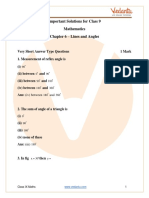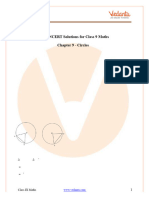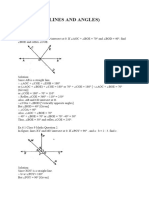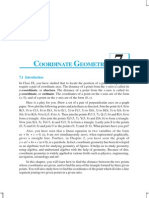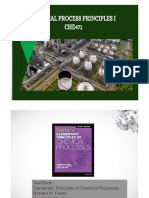NCERT Solutions For Class 9 Maths Chapter 6 Lines and Angles.
NCERT Solutions For Class 9 Maths Chapter 6 Lines and Angles.
Uploaded by
Shubhangi GanvirCopyright:
Available Formats
NCERT Solutions For Class 9 Maths Chapter 6 Lines and Angles.
NCERT Solutions For Class 9 Maths Chapter 6 Lines and Angles.
Uploaded by
Shubhangi GanvirOriginal Title
Copyright
Available Formats
Share this document
Did you find this document useful?
Is this content inappropriate?
Copyright:
Available Formats
NCERT Solutions For Class 9 Maths Chapter 6 Lines and Angles.
NCERT Solutions For Class 9 Maths Chapter 6 Lines and Angles.
Uploaded by
Shubhangi GanvirCopyright:
Available Formats
`
NCERT Solutions For Class 9
Maths
Chapter 6-Lines and Angles
Exercise-6.1
1. In the given figure, lines AB and CD intersect at O. if AOC+BOE=70o
and BOD=40o find BOE and reflex COE
Ans: AB is a straight line, OC and OE are rays from O.
We know that a straight line covers 180
AOC+COE+BOE=180
By clubbing AOC and BOE together we can rewrite the above equation as
( AOC+BOE ) + COE=180
Putting AOC+BOE=70
. COE=180 -70
COE=110
Hence reflex COE=360 -110
reflexCOE=250
Similarly CD is a straight line, OB and OE are rays from O.
We know that a straight line covers 180
BOD+COE+BOE=180
Class IX Maths www.vedantu.com 1
`
40 +110 +BOE=180
BOE=180 - ( 40 +110 )
BOE=180 -150
BOE=30
Hence BOE=30 and reflex COE=250
2.In the given figure, lines XY and MN intersect at O. If POY=90o and a: b
= 2:3, find c.
Ans: Let the common ratio between a and b be x.
a = 2x , and b = 3x
XY is a straight line, OM and OP are rays from O.
We know that a straight line covers 180
XOM +MOP +POY = 180o
Putting values for XOM=b andMOP=a
b + a +POY = 180o
3x + 2x +POY = 180o
5x = 90o
x = 18o
a = 2x
a = 2 18
= 36
Class IX Maths www.vedantu.com 2
`
b = 3x
b = 3 18
= 54
Similarly MN is a straight line, OX is a ray from O
b+c=180
54o + c = 180o
c = 180 − 54
c = 126
3.In the given figure, PQR=PRQ , then prove that PQS=PRT .
Ans: ST is a straight line, QP is a line segment from Q in ST to any point P
by Linear Pair property
PQS+PQR=180o
PQR=180o -PQS ......(1 )
Similarly
PRT + PRQ = 180
PRQ=180o -PRT ......( 2 )
Now in the question it is given that PQR=PRQ
Therefore on equating equation (1 ) and ( 2 ) we get
180o -PQS=180o -PRT
PQS=PRT
Hence proved
4.In the given figure, if x+y=w+z then prove that AOB is a line.
Class IX Maths www.vedantu.com 3
`
Ans: It can be observed that,
Since there are 360 around a point therefore we can write
x + y + z + w = 360
It is given that,
x+y=w+z
Therefore writing x+y in place of w+z so that we can eliminate w and z, we get
x + y + x + y = 360
2 ( x + y ) = 360
x + y = 180
Since x and y form a linear pair, hence we can say that AOB is a line.
Hence proved
5.In the given figure, POQ is a line. Ray OR is perpendicular to line PQ. OS is
another ray lying between rays OP and OR. Prove that
1
ROS= ( QOS-POS )
2
Class IX Maths www.vedantu.com 4
`
Ans: Since OR ⊥ PQ therefore
POR=90o
POS + ROS = 90
ROS=90o -POS ...... (1 )
Similarly QOR=90o (Since OR^PQ )
QOS-ROS=90o
ROS=QOS-90o ......( 2 )
We can clearly see that on adding equation (1 ) and ( 2 ) 90 get canceled out
2ROS=QOS-POS
Which can easily be written as
1
ROS= ( ROS-POS)
2
Hence proved
6.It is given that ÐXYZ=64o and XY is produced to point P. Draw a figure
from the given information. If ray YQ bisects ÐZYP , find ÐXYQ and
reflex ÐQYP .
Ans: It is given that line YQ bisects ZYP .
Hence, QYP=ZYQ
It can easily be understood that PX is a line, YQ and YZ being rays standing on it.
XYZ+ZYQ+QYP=180o
From above relation QYP=ZYQ we can write
64o +2QYP=180o
Class IX Maths www.vedantu.com 5
`
2QYP=180o -64o
QYP=58
Therefore ZYQ=58
Also Reflex QYP=302
Now we can write XYQ as below
XYQ=XYZ+ZYQ
64 + 58 = 122
Therefore we found XYQ=122 and so the Reflex QYP=302
Exercise-6.2
1.In the given figure, find the values of x and y and then show that AB CD.
Ans: From the figure it is clear that,
50 + x = 180 (Linear Pair)
x=130o ......(1 )
Class IX Maths www.vedantu.com 6
`
Also, from the figure it is clear that y = 130 (since vertically opposite angles are
equal)Similarly we can see that x and y are alternate interior angles for lines AB
and CD and so measures of these angles are equal to each other.
Therefore, line AB || CD.
Hence proved.
2.In the given figure, if AB CD, CD EF and y: z = 3:7, find x.
Ans: It is given that AB CD and CD EF
AB CD EF (Lines parallel to other fixed line are parallel to each other)
It can easily be understood that
x=z (since alternate interior angles are equal) ...... ( 1 )
It is given that y: z = 3: 7
Without any loss of generality we can let y=3a and z=7a
Also, x+y=180o (Co-interior angles together sum up to 180 )
From equation (1 ) we can write z in place of x as shown
z+y=180o
It can further written as shown
7a + 3a = 180
10a=180o
a=18o
x=7×18o
x=126o
Class IX Maths www.vedantu.com 7
`
3.In the given figure, If AB CD, EF ⊥ CD and GED=126o , find AGE ,
GEF and FGE .
Ans: We are given that,
AB CD and EF ⊥ CD and
GED=126o
Which can be written as
GEF+FED=126o
GEF+90o =126o
Hence we can obtain ÐGEF as shown below
GEF=126o -90o
GEF=36
AGE=GED=126o (∠AGE and ∠GED are alternate interior angles)
But AGE+FGE=180o (because these form a linear pair)
126o +FGE=180o
FGE=180o -126o
FGE=54o
Hence, we found AGE=126o , GEF=36o , FGE=54o
4.In the given figure, if PQ ST, PQR=110o and RST=130o , find QRS .
[Hint: Draw a line parallel to ST through point R.]
Class IX Maths www.vedantu.com 8
`
Ans:
In this question we will have some construction of our own, we draw a line XY
parallel to ST and so parallel to PQ passing through point R.
PQR+QRX=180o (Co-interior angles on the same side of transversal QR
together sum up to 180 )
110o +QRX=180o
QRX=70o
Also,
RST+SRY=180 (sum of Co-interior angles on the same side of transversal
SR equals 180 )
SRY=180 -130
SRY=50
Now from the construction XY is a straight line. RQ and RS are rays from it.
QRX+QRS+SRY=180
70 + QRS + 50 = 180
Hence we found that
Class IX Maths www.vedantu.com 9
`
QRS=60
5.In the given figure, if AB CD, APQ = 50 and PRD = 127 , find x and y.
Ans: APR = PRD (since alternate interior angles are equal)
50 + y = 127 (since APR = APQ+PQR )
y=77
similarly,
APQ=PQR ∠APQ = ∠PQR (since alternate interior angles are equal)
x=50
Therefore we found that x=50 and y=77
6.In the given figure, PQ and RS are two mirrors placed parallel to each other.
An incident ray AB strikes the mirror PQ at B, the reflected ray moves along
the path BC and strikes the mirror RS atC and again reflects back along CD.
Prove that AB||CD.
Ans:
Class IX Maths www.vedantu.com 10
`
Let us construct BM ⊥ PQ and CN ⊥ RS.
Since PQ RS, and so BM CN
Therefore, CN and BM are two parallel lines and a transversal line BC cuts them
at B and C respectively.
∠2 = ∠3......(1 ) (since alternate interior angles are equal)
But, by laws of reflection in Physics
∠1 = ∠2 and ∠3 = ∠4
Now from equation (1 )
∠1 = ∠2 = ∠3 = ∠4
Therefore
∠1 + ∠2 = ∠3 + ∠4
ABC= DCB
But, these are alternate interior angles.
AB CD
Hence proved.
Exercise-6.3
1.In the given figure, sides QP and RQ of PQR are produced to points S and
T respectively. If ∠SPR = 135o and ∠PQT = 110o, find ∠PRQ.
Class IX Maths www.vedantu.com 11
`
Ans: We are given that,
SPR=135 and PQT=110
Therefore we can write
SPR+QPR=180 (since Linear pair angles equals 180 )
135 + QPR=180
QPR=45
Similarly PQT+PQR=180 (Linear pair angles)
110 + PQR = 180
From here we get
PQR=70
Considering PQR,
QPR+PQR+PRQ = 180 (sum of all interior angles of a triangle is 180 )
45 + 70 + PRQ = 180
Hence we found that
PRQ=65
Class IX Maths www.vedantu.com 12
`
2.In the given figure, X=62 , XYZ=54 . If YO and ZO are the bisectors of
XYZ and XZY respectively of XYZ, find OZY and YOZ .
Ans: We know that the sum of all interior angles of a triangle is 180 , therefore,
for XYZ,
X+XYZ+XZY
62 + 54 + XZY=180
Hence we get
XZY=64
54
Similarly OZY = 27 (since OZY = )
2
From OYZ we obtain
OZY + YOZ + OZY = 180 ?(using angle sum property of a triangle)
27 + YOZ + 32 = 180
From here we get
YOZ = 121
Hence we found that, OZY = 27 and YOZ = 121
Class IX Maths www.vedantu.com 13
`
3.In the given figure, if AB DE, BAC=35 and CDE=53 , find DCE .
Ans: From the figure we can easily see AB DE and AE is a transversal.
BAC = CED (since alternate interior angles are equal)
CED=35
In CDE,
CDE+CED+DCE=180 (from the angle sum property of a triangle)
53 + 35 + DCE = 180
From here we get
DCE = 92
4.In the given figure, if lines PQ and RS intersect at point T, such that
PRT=40 , RPT = 95 and TSQ=75 , find STQ
Ans: On applying angle sum property for PRT, we find
PRT+RPT+PTR=180
40 + 95 + PTR = 180
From here we get
Class IX Maths www.vedantu.com 14
`
PTR=45
Now in STQ
STQ = PTR (since they are vertically opposite angles)
STQ = 45
Similarly on applying angle sum property for STQ, we find
STQ+SQT+QST=180
45 + STQ + 75 = 180
Hence we found that
SQT=60
5.In the given figure, if PQ ⊥ PS, PQ SR, SQR=28 and QRT=65 then
find the values of x and y.
Ans: We are given that PQ SR and QR is a transversal line.
PQR=QRT (since alternate interior angles are equal)
x + 28 = 65 (since PQR=PQS + SQR )
From here we get
x=37
By applying the angle sum property for SPQ, we find
SPQ + x + y = 180
90 + 37 + y = 180
From here we get
y=53
Class IX Maths www.vedantu.com 15
`
Hence we found and x=37 and y=53
6.In the given figure, the side QR of PQR is produced to a point S. If the
bisectors of PQR and PRS meet at point T, then prove that
1
QTR= QPR .
2
Ans: In QTR ,we can easily observe ∠TRS is an exterior angle.
QTR+TQR=TRS
QTR=TRS-TQR ...... (1 )
In PQR, we can easily observe PRS is an external angle.
QPR + PQR = PRS
QPR + 2TQR = 2TRS (Given QT and RT are angle bisectors)
QPR=2 ( TRS-TQR )
QPR = 2QTR (from equation 1 )
1
Hence QPR = QTR proved.
2
Class IX Maths www.vedantu.com 16
You might also like
- 757-767 Study GuideDocument155 pages757-767 Study Guideaske7sp8055100% (3)
- Impulse PPT DemoDocument18 pagesImpulse PPT DemoJonathan M. Abellera100% (1)
- Citizen Instruction Manual 8200Document2 pagesCitizen Instruction Manual 8200davidgloomNo ratings yet
- NCERT Solutions Class 9 Maths Exercise 6.1 Chapter 6 - Lines and AnglesDocument15 pagesNCERT Solutions Class 9 Maths Exercise 6.1 Chapter 6 - Lines and AnglesNaina RoyNo ratings yet
- 9maths 6 Lines and AnglesDocument19 pages9maths 6 Lines and Anglesamir shaharanNo ratings yet
- NCERT Solutions For Class 9 Maths Chapter 6-Lines and AnglesDocument16 pagesNCERT Solutions For Class 9 Maths Chapter 6-Lines and AnglesPrerakNo ratings yet
- Lines & Angles NCERT SolutionsDocument19 pagesLines & Angles NCERT Solutionsbhagyashree.karkareNo ratings yet
- Important Questions For CBSE Class 9 Maths Chapter 6 - Lines and AnglesDocument69 pagesImportant Questions For CBSE Class 9 Maths Chapter 6 - Lines and AnglesKANISHKA ATTRINo ratings yet
- NCERT Solutions For Class 9 Maths Chapter 6 Lines and AnglesDocument15 pagesNCERT Solutions For Class 9 Maths Chapter 6 Lines and AnglesDr. J. Josephine JACNo ratings yet
- Chapter 6Document12 pagesChapter 6Aryan VermaNo ratings yet
- Ncert ExercisesDocument17 pagesNcert ExercisesHimanshu JethwaniNo ratings yet
- chap6_linesAnglesDocument9 pageschap6_linesAnglesviksonioNo ratings yet
- Aakash Institute: NCERT Solutions For Class 9 Maths Chapter 6 Lines and Angles Excercise: 6.1Document20 pagesAakash Institute: NCERT Solutions For Class 9 Maths Chapter 6 Lines and Angles Excercise: 6.1Flaze MartinoNo ratings yet
- Lines and AnglesDocument28 pagesLines and AnglesAnsh SinghNo ratings yet
- Exercise: 6.2 (Page No: 103)Document5 pagesExercise: 6.2 (Page No: 103)Nitin ChaudharyNo ratings yet
- NCERT Solutions For Class 9 Maths Chapter 6 Exercise 6.2 - Free PDF 2024Document8 pagesNCERT Solutions For Class 9 Maths Chapter 6 Exercise 6.2 - Free PDF 2024Naina RoyNo ratings yet
- Ncert Solutions Class 9 Math Chapter 6 Lines and Angles Ex 6 1Document10 pagesNcert Solutions Class 9 Math Chapter 6 Lines and Angles Ex 6 1aaravcr54No ratings yet
- NCERT Solutions For CBSE Class 10 Maths Chapter 10 CirclesDocument15 pagesNCERT Solutions For CBSE Class 10 Maths Chapter 10 CirclesJayant KumarNo ratings yet
- NCERT Solutions for Class 9 Maths Chapter 6 Lines and Angles Ex 6Document15 pagesNCERT Solutions for Class 9 Maths Chapter 6 Lines and Angles Ex 6naikjayanth46No ratings yet
- Canadian Open Mathematics Challenge: The Canadian Mathematical SocietyDocument10 pagesCanadian Open Mathematics Challenge: The Canadian Mathematical Societyสฮาบูดีน สาและNo ratings yet
- Euclid Workshop SolutionsDocument5 pagesEuclid Workshop SolutionsVenkat VenkataramananNo ratings yet
- SMO 2007 Open SolutionDocument11 pagesSMO 2007 Open Solutionwmdsg100% (1)
- NCERT Solutions For Class 9 Maths Chapter 9 - CirclesDocument24 pagesNCERT Solutions For Class 9 Maths Chapter 9 - CirclesDIANA MARY ANTONY SAMYNo ratings yet
- Chapter 6 Class 9Document11 pagesChapter 6 Class 9raikaindraj58No ratings yet
- NCERT Solutions For Class 9 Maths Chapter 6 Lines and Angles Exercise 6 1Document5 pagesNCERT Solutions For Class 9 Maths Chapter 6 Lines and Angles Exercise 6 1divyanshtyagi910No ratings yet
- The Gergonne Problem: Nikolaos DergiadesDocument5 pagesThe Gergonne Problem: Nikolaos DergiadesBoris Mendoza PortolatinoNo ratings yet
- Ncert Solutions Class 9 Math Chapter 6 Lines and Angles Ex 6 2Document9 pagesNcert Solutions Class 9 Math Chapter 6 Lines and Angles Ex 6 2hofog31426No ratings yet
- Comc2000 Official Solutions en PDFDocument10 pagesComc2000 Official Solutions en PDFafaflotfi_155696459No ratings yet
- Jemh 107Document18 pagesJemh 107myNo ratings yet
- Most Important Questions (Class 10 Maths) CircleDocument13 pagesMost Important Questions (Class 10 Maths) CircleSreshta shreeNo ratings yet
- Maths Class X Chapter 10 Circles Practice Paper 09 AnswersDocument11 pagesMaths Class X Chapter 10 Circles Practice Paper 09 AnswersPaarvathy RamakrishnanNo ratings yet
- SMO 2006 Open SolutionDocument9 pagesSMO 2006 Open Solutionwmdsg100% (1)
- 10 CirclesDocument20 pages10 CirclesMp SunilNo ratings yet
- NCERT Exemplar For Class 9 Maths Chapter 6 - Lines and Angles (Book Solutions)Document23 pagesNCERT Exemplar For Class 9 Maths Chapter 6 - Lines and Angles (Book Solutions)shivanshv2010No ratings yet
- Inmo 2001Document6 pagesInmo 2001Ashutosh SinghNo ratings yet
- Lines and AnglesDocument5 pagesLines and Angleschoudhurydhirendra616No ratings yet
- Circle Geometry SolutionsDocument5 pagesCircle Geometry Solutionsscribd-in-actionNo ratings yet
- Class 10 Chapter 10 Maths Important QuestionDocument13 pagesClass 10 Chapter 10 Maths Important Questionswarnimadas935No ratings yet
- Chap 7Document18 pagesChap 7sameerchopadeNo ratings yet
- Selina Concise Mathematics Class 10 Solutions Chapter 18Document112 pagesSelina Concise Mathematics Class 10 Solutions Chapter 18tejassilimkar06No ratings yet
- Regional Mathematical Olympiad-2000 Problems and SolutionsDocument4 pagesRegional Mathematical Olympiad-2000 Problems and SolutionsAbhishek SinghNo ratings yet
- GMAT Geometry 1Document17 pagesGMAT Geometry 1anon_114859983No ratings yet
- Ncert Solutions For Class 10 Maths Chapter 10Document15 pagesNcert Solutions For Class 10 Maths Chapter 10Aaryan KumarNo ratings yet
- ACFrOgD8W56mkVe 9mqjEIEgpO2rIaLN10 6XjCti3zy9IE7IktCm3K5KB0upTL616y7JsMAJg2Sk1cJ1YxkS5nF NeBDvLR6vpgh FOP6S2drOsOy8y0vK m7YrOlhvTbtiJjEn UpRLjKiK8qDocument16 pagesACFrOgD8W56mkVe 9mqjEIEgpO2rIaLN10 6XjCti3zy9IE7IktCm3K5KB0upTL616y7JsMAJg2Sk1cJ1YxkS5nF NeBDvLR6vpgh FOP6S2drOsOy8y0vK m7YrOlhvTbtiJjEn UpRLjKiK8q0669Manya VermaNo ratings yet
- Oordinate EometryDocument18 pagesOordinate EometryNITISH KUMARNo ratings yet
- PDF&Rendition 1Document46 pagesPDF&Rendition 1abijk81No ratings yet
- Maths Model Test Paper For Summative Assessment - 3Document14 pagesMaths Model Test Paper For Summative Assessment - 3Apex Institute100% (1)
- Lines and AnglesDocument63 pagesLines and Anglesthinkiit100% (1)
- Circles Set-A AnswersDocument11 pagesCircles Set-A Answerssonakshisahu81No ratings yet
- CH 6Document16 pagesCH 6jainanant806No ratings yet
- Math 107Document18 pagesMath 107ShailendraPatelNo ratings yet
- NCERT Solutions For Class 10 Maths Chapter 10 Circles Exercise 10.2Document13 pagesNCERT Solutions For Class 10 Maths Chapter 10 Circles Exercise 10.2Gurleen kaur Comedy VideosNo ratings yet
- Circles Class 10 Extra QuesDocument30 pagesCircles Class 10 Extra QuesSonal DubeyNo ratings yet
- Exercise 13.2Document20 pagesExercise 13.2Nilay 3110No ratings yet
- De Moiver's Theorem (Trigonometry) Mathematics Question BankFrom EverandDe Moiver's Theorem (Trigonometry) Mathematics Question BankNo ratings yet
- Transformation of Axes (Geometry) Mathematics Question BankFrom EverandTransformation of Axes (Geometry) Mathematics Question BankRating: 3 out of 5 stars3/5 (1)
- Mathematical Analysis 1: theory and solved exercisesFrom EverandMathematical Analysis 1: theory and solved exercisesRating: 5 out of 5 stars5/5 (1)
- Trigonometric Ratios to Transformations (Trigonometry) Mathematics E-Book For Public ExamsFrom EverandTrigonometric Ratios to Transformations (Trigonometry) Mathematics E-Book For Public ExamsRating: 5 out of 5 stars5/5 (1)
- Application of DerivativesDocument3 pagesApplication of DerivativesKeshav AgarwalNo ratings yet
- BirdDocument8 pagesBirdFionaNo ratings yet
- Heat CalculationDocument4 pagesHeat CalculationnajihahNo ratings yet
- Ace 6 PDFDocument4 pagesAce 6 PDFCharles John CatanNo ratings yet
- Lecture Slide Week 1 20222 PDFDocument19 pagesLecture Slide Week 1 20222 PDFMUHAMMAD LUQMAN HAKIMI MOHD ZAMRINo ratings yet
- Fieldvue DVC5000f Series Digital Valve Controllers For F FieldbusDocument12 pagesFieldvue DVC5000f Series Digital Valve Controllers For F FieldbusDatt NguyenNo ratings yet
- Institute of Teacher Education Syllabus in Ethics: Iv. Program Specialization OutcomesDocument15 pagesInstitute of Teacher Education Syllabus in Ethics: Iv. Program Specialization OutcomesJE QUESTNo ratings yet
- Lecture 5 - Orthographic ProjectionDocument56 pagesLecture 5 - Orthographic ProjectionLaiba KhanNo ratings yet
- APIi 650 DimensionsDocument1 pageAPIi 650 Dimensionsdeden okNo ratings yet
- Maths Answer+key 01jpa,+02jpaDocument5 pagesMaths Answer+key 01jpa,+02jpaHardik TiwariNo ratings yet
- Quiz Data Management MMW FINAL 1Document30 pagesQuiz Data Management MMW FINAL 1hannah patricia estrellanaNo ratings yet
- CPP MCQDocument7 pagesCPP MCQshahajibabar063No ratings yet
- 2018 Sample MATH M1 Level5 EDocument25 pages2018 Sample MATH M1 Level5 EKelvin LauNo ratings yet
- Instructions MH6S PDFDocument62 pagesInstructions MH6S PDFEvandro PavesiNo ratings yet
- Calculations in Natural Gas CourseDocument6 pagesCalculations in Natural Gas CourseVijay KumarNo ratings yet
- CSM-320EW Network Information Management and Control Device HardwareDocument16 pagesCSM-320EW Network Information Management and Control Device HardwareMarkusKunNo ratings yet
- CPP Oop Part2 A3Document21 pagesCPP Oop Part2 A3semabayNo ratings yet
- Vibration Reference GuideDocument2 pagesVibration Reference GuideErez Matana100% (2)
- Stereochemistry Chm125Document81 pagesStereochemistry Chm125Nurin AthirahNo ratings yet
- BTMini WiFi Manual Eng V1 4xDocument33 pagesBTMini WiFi Manual Eng V1 4xAmit PatelNo ratings yet
- The Solution of Differential Equations Using Laplace TransformsDocument5 pagesThe Solution of Differential Equations Using Laplace TransformsChainarong TaepanichNo ratings yet
- Explainable Artificial Intelligence Applied To Deep Reinforcement Learning Controllers For Photovoltaic Maximum Power Point TrackingDocument5 pagesExplainable Artificial Intelligence Applied To Deep Reinforcement Learning Controllers For Photovoltaic Maximum Power Point Trackingindra setyawanNo ratings yet
- Arpit Mishra Project WorkDocument62 pagesArpit Mishra Project WorkarpitNo ratings yet
- Original PDFDocument2 pagesOriginal PDFAlexander P BelkaNo ratings yet
- Effects of EarthquakeDocument4 pagesEffects of EarthquakeRichard PascoNo ratings yet
- Nama: Matriapsi Yoel Talan Nim: 20180303036 Tugas Pertemuan 13 BiostatistikDocument14 pagesNama: Matriapsi Yoel Talan Nim: 20180303036 Tugas Pertemuan 13 Biostatistikyan kify mohiNo ratings yet
- Fdd390N15Alz: N-Channel Powertrench MosfetDocument9 pagesFdd390N15Alz: N-Channel Powertrench Mosfetserrano.flia.coNo ratings yet







